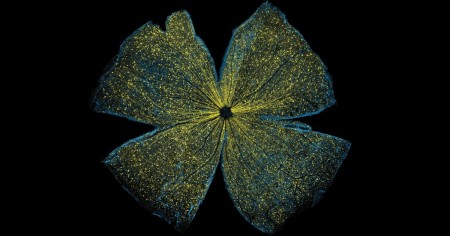NIH: The retina, like this one from a mouse that is flattened out and
captured in a beautiful image, is a thin tissue that lines the back of
the eye. Although only about the size of a postage stamp, the retina
contains more than 100 distinct cell types that are organized into
multiple information-processing layers. These layers work together to
absorb light and translate it into electrical signals that stream via
the optic nerve to the brain. In people with inherited disorders in which the retina degenerates,
an altered gene somewhere within this nexus of cells progressively robs
them of their sight.
This has led to a number of human clinical
trials—with some encouraging progress being reported for at least one
condition, Leber congenital amaurosis—that are transferring a normal
version of the affected gene into retinal cells in hopes of restoring
lost vision.
To better understand and improve this potential therapeutic strategy,
researchers are gauging the efficiency of gene transfer into the retina
via an imaging technique called large-scale mosaic confocal microscopy,
which computationally assembles many small, high-resolution images in a
way similar to Google Earth. In the example you see above,
NIH-supported researchers Wonkyu Ju, Mark Ellisman, and their colleagues
at the University of California, San Diego, engineered adeno-associated
virus serotype 2 (AAV2) to deliver a dummy gene tagged with a
fluorescent marker (yellow) into the ganglion cells (blue) of a mouse
retina. Two months after AAV-mediated gene delivery, yellow had overlaid
most of the blue, indicating the dummy gene had been selectively
transferred into retinal ganglion cells at a high rate of efficiency
[1].
The researchers also used AAV2 to deliver
into the retinas of mice a gene that coded for a mutant version of a
protein, called DRP1. They found it inhibited normal DRP1 protein and
stopped retinal ganglion cells from dying in response to glaucoma, a
vision-threatening condition that elevates pressure within the eye. The
gene transfer proved successful in rescuing the retinal ganglion cells,
and researchers are continuing to pursue this line of study with the aim
of translating their discoveries into possible ways of helping humans
with glaucoma.
It’s also worth noting that this image recently took top honors in
the NIH Institute and Centers Art Challenge, which was held in October
as part of the Combined Federal Campaign, in which federal employees
make their annual contributions to charitable organizations. The art
competition had a number of outstanding entrants, some of which will be
on display during November at the NIH Clinical Center in Bethesda, MD.
If you’re in the neighborhood, come take a look!
References:
[1] DRP1
inhibition rescues retinal ganglion cells and their axons by preserving
mitochondrial integrity in a mouse model of glaucoma. Kim KY, Perkins GA, Shim MS, Bushong E, Alcasid N, Ju S, Ellisman MH, Weinreb RN, Ju WK. Cell Death Dis. 2015 Aug 6;6:e1839.
